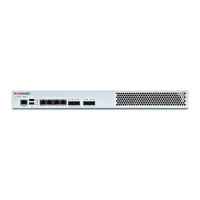Planning the network topology How to set up your FortiWAN
LAN. FortiWAN provides physical ports for the DMZ purpose.
FortiWAN is an edge device which basically play the role connecting internal and external networks via the network
interfaces (called ports as well). With the definitions on each port (See "Default Port Mappings") and correct network
settings (See "Configuring Network Interface"), the networks (WAN, DMZ and LAN) connected to FortiWAN can
function appropriately.
Default port mappings
The network ports (physical ports) on the panel of FortiWAN appliance are used to connect networks to FortiWAN.
Purposes of these network ports are defined for different types of network connections. A network port can be mapped
to the following types:
l WAN port: is used to connect FortiWAN with a WAN network.
l LAN port: is used to connect FortiWAN with a LAN network.
l DMZ port: is used to connect FortiWAN with a DMZ network.
l
HA port: is used to connect two FortiWAN units for HA deployment (See "FortiWAN in HA (High Availability)
Mode").
Connections have to correspond with the port types.
Except the HA port, each port can be programmed as WAN, LAN or DMZ via Web UI. Moreover, redundant LAN and
DMZ ports, and 2-link LACP/LAG LAN or DMZ ports can be configured (See "Configurations for VLAN and Port
Mapping"). However, you might to know the default port mapping for the first time you access the Web UI (See
"Connecting to the web UI and the CLI") and have the correct network setting applied (See "Configuring Network
Interface"). All the network ports on the panel of FortiWAN appliance are numbered, and the default mappings are as
follows:
Ports Supported WAN Ports LAN Port DMZ Port
FortiWAN
200B
5 GE RJ45 ports Port 1 ~ Port 3 Port 4 Port 5
FortiWAN
1000B
3 GE RJ45 ports and 4 GE SFP ports Port 1 ~ Port 5 Port 6 Port 7
FortiWAN
3000B
8 GE RJ45 ports, 8 GE SFP ports and 8
10GE SFP+ ports
Port 1 ~ Port
10
Port 11 Port 12
FortiWAN VM 10 vNICs vNIC 2 vNIC 3 vNIC 4
FortiWAN 3000B's Prot 13 ~ Port 24 and FortiWAN VM's vNIC 5 ~ vNIC 10 are undefined by default, they can be
defined via Web UI (See "VLAN and Port Mapping").
FortiWAN Handbook
Fortinet Technologies Inc.
21

